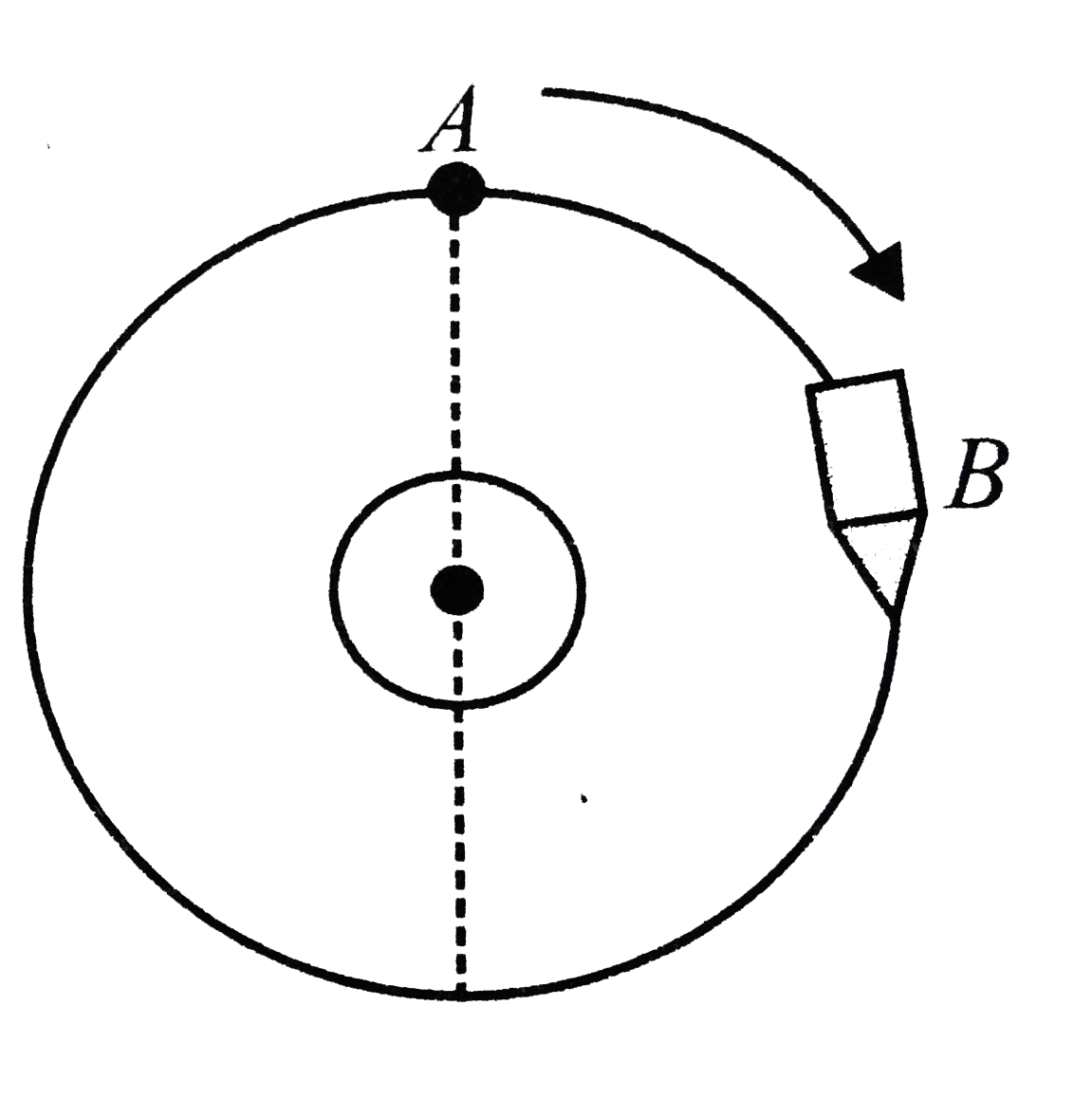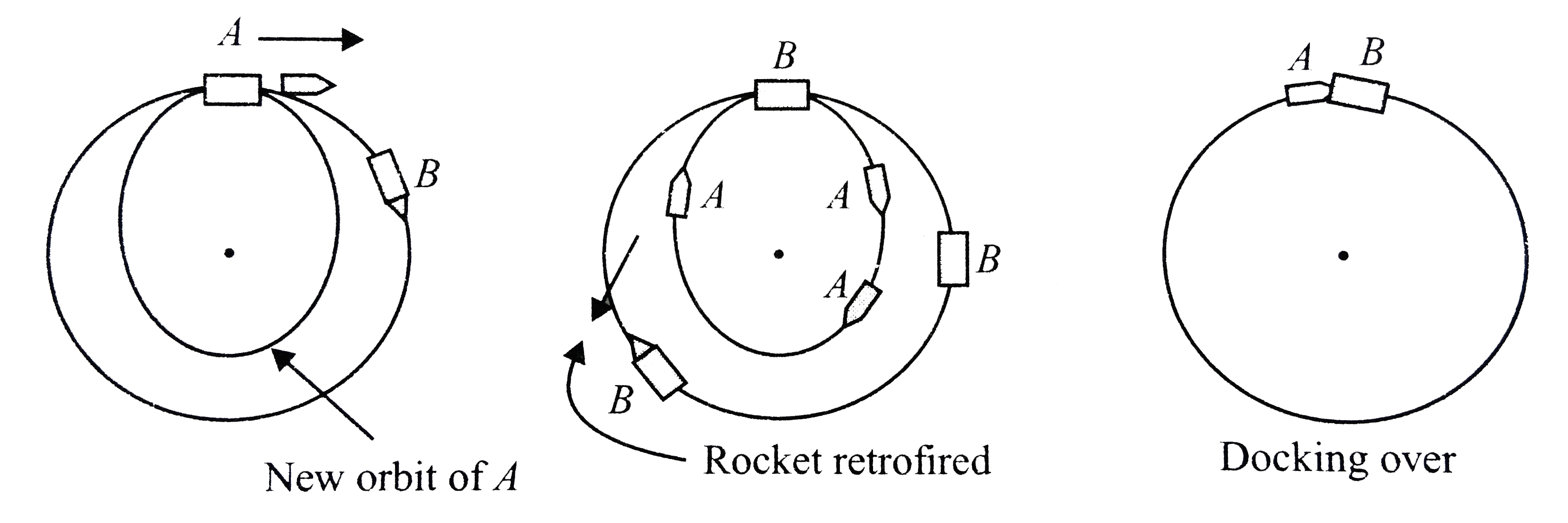In December 2018, India’s heaviest satellite ....... went into orbit on a French rocket to help boost broadband intemet services in India.
GSAT-6
GSAT-19
GSAT-17
GSAT-11
The correct Answer is:D
GSAT-11
Similar Questions
The first known collision between space debris and a functioning satellite occurred in 1996: At an altitude of 700 km, a year-old French spy satellite was hit by a piece of an Ariane rocket. A stabilizing boom on the satellite was demolished, and the satellite was sent spinning out of control. Just before the collision and in kilometers per hour, what was the speed of the rocket piece relative to the satellite if both were in circular orbits and the collision was (a) head-on and (b) along perpendicular paths?
View SolutionAn unmanned satellite A and a spacecraft B are orbiting around the earth in the same circular orbit as shown.
 The spacecraft is ahead of the satellite by some time. Let us consider that some technical problem has arisen in the satellite and the astronaut from B has made it correct. For this to be done docking of two (A and B) is required (in layman terms connecting A and B). To achieve this, the rockets of A have been fired in forward direction and docking takes place as shown in the figure below:
The spacecraft is ahead of the satellite by some time. Let us consider that some technical problem has arisen in the satellite and the astronaut from B has made it correct. For this to be done docking of two (A and B) is required (in layman terms connecting A and B). To achieve this, the rockets of A have been fired in forward direction and docking takes place as shown in the figure below:

Take mass of the earth =5.98×1024kg
Radius of the earth =6400km
Orbital radius =9600km
Mass of satellite A=320kg
Mass of spacecraft =3200kg
Assume that initially spacecraft B leads satellite A by 100s, i.e., A arrives at any particle position after 100s of B’s arrival. Based on the above information answer the following questions. After once returning to the original point, i.e., the place from where the rockets have been fired, in which direction and with what extent the rockets have to be fired from the satellite to again come back in the original orbit?View Solution
Knowledge Check
- Question 1 - Select One
India recently launched a satellite in orbit for the purpose of-
AEducationBMarine ExplorationCMission to MoonDResource Evaluation - Question 2 - Select One
Consider the following statements:
1. Chennai has become India’s first Wi-Fienabled metro city.
2. Private telecom operator, Reliance Jio is providing the 4G enabled Wi-fi services in the city.
Which of the statements given above is/are correct?A1 onlyB2 onlyCBoth 1 and 2DNeither of the above - Question 3 - Select One
In November 2018, ......... electronics company CASIO launched the world‘s first Goods and Services Tax (GST) calculator in India.
AJapaneseBUKCUSDChinese
The Government of India has approved year 2018 as National year of which nutrient rich crop to boost its production?
View SolutionWhich country in July , 2015 launched its heaviest commercial space mission ever with its polar rocket successfully putting five British satellites in the Sun synchronous orbit?
View SolutionThe Indian Space Research Organisation boosted its reputation further when it successfully launched a record 104 satellites in one mission from Sriharikota on 15th February, 2017 by relying on its workhorse PSLV rocket. An earth observation Cartosat-2 series satellite and two other nano satellites were the only Indian satellites launched: the remaining were from the United States, Israel, the UAE. the Netherlands, Kazakhstan and Switzerland. Of the 101 foreign satellites launched, 96 were from the U.S. and one each from the other five countries. Till now Russia held the record of launching 37 satellites in a single mission, in 2014, while the National Aeronautics and Space Administration of the U.S. launched 29 satellites in one go in 2013. Last June, ISRO had come close to NASA's record by launching 20 satellites in one mission. But ISRO views the launch not as a mission to set a world record but as an opportunity to make full use of the capacity of the launch vehicle. The launch is particularly significant as ISRO now cements its position as a key player in the lucrative commercial space launch market by providing a cheaper yet highly reliable alternative. At an orbital altitude of around 500 km, the vehicle takes about 90 minutes to complete one orbit. Though ISRO had sufficient time to put the satellites into orbit, it accomplished the task in about 12 minutes. With the focus on ensuring that no two satellites collided with each other, the satellites were injected in pairs in opposite directions. Successive pairs of satellites were launched once the vehicle rotated by a few degrees, thereby changing the separation angle and time of separation to prevent any collision. Besides setting the record for the most number of satellites launched in a single mission, the Indian space agency has launched two nano satellites weighing less than 10 kg. It is a technology demonstrator for a new class of satellites called ISRO nano satellites (INS). With many Indian universities already building and launching nano satellites, the availability of a dedicated nano satellites platform is sure to boost space research in India.
Why the recent launch of satellite is significant to ISRO?View SolutionThe Indian Space Research Organisation boosted its reputation further when it successfully launched a record 104 satellites in one mission from Sriharikota on 15th February, 2017 by relying on its workhorse PSLV rocket. An earth observation Cartosat-2 series satellite and two other nano satellites were the only Indian satellites launched: the remaining were from the United States, Israel, the UAE. the Netherlands, Kazakhstan and Switzerland. Of the 101 foreign satellites launched, 96 were from the U.S. and one each from the other five countries. Till now Russia held the record of launching 37 satellites in a single mission, in 2014, while the National Aeronautics and Space Administration of the U.S. launched 29 satellites in one go in 2013. Last June, ISRO had come close to NASA's record by launching 20 satellites in one mission. But ISRO views the launch not as a mission to set a world record but as an opportunity to make full use of the capacity of the launch vehicle. The launch is particularly significant as ISRO now cements its position as a key player in the lucrative commercial space launch market by providing a cheaper yet highly reliable alternative. At an orbital altitude of around 500 km, the vehicle takes about 90 minutes to complete one orbit. Though ISRO had sufficient time to put the satellites into orbit, it accomplished the task in about 12 minutes. With the focus on ensuring that no two satellites collided with each other, the satellites were injected in pairs in opposite directions. Successive pairs of satellites were launched once the vehicle rotated by a few degrees, thereby changing the separation angle and time of separation to prevent any collision. Besides setting the record for the most number of satellites launched in a single mission, the Indian space agency has launched two nano satellites weighing less than 10 kg. It is a technology demonstrator for a new class of satellites called ISRO nano satellites (INS). With many Indian universities already building and launching nano satellites, the availability of a dedicated nano satellites platform is sure to boost space research in India.
What can be the suitable title to the passage ?View SolutionAn unmanned satellite A and a spacecraft B are orbiting around the earth in the same circular orbit as shown.

The spacecraft is ahead of the satellite by some time. Let us consider that some technical problem has arisen in the satellite and the astronaut from B has made it correct. For this to be done docking of two (A and B) is required (in layman terms connecting A and B). To achieve this, the rockets of A have been fired in forward direction and docking takes place as shown in the figure below:

Take mass of the earth =5.98×1024kg
Radius of the earth =6400km
Orbital radius =9600km
Mass of satellite A=320kg
Mass of spacecraft =3200kg
Assume that initially spacecraft B leads satellite A by 100s, i.e., A arrives at any particle position after 100s of B’s arrival. Based on the above information answer the following questions. After once returning to the original point, i.e., the place from where the rockets have been fired, in which direction and with what extent the rockets have to be fired from the satellite to again come back in the original orbit?View Solution

